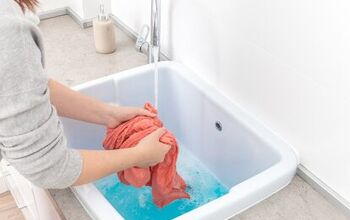Will A Dehumidifier In The Basement Help The Whole House?

Many homes across the US have basements for extra storage or finished basements can add substantial square footage to your living space. When it comes to indoor air quality, basements present their own unique set of issues, specifically, moisture control. To tackle these environmental difficulties, homeowners often install a basement dehumidifier, but will a dehumidifier in the basement help the whole house?
A dehumidifier in the basement helps the whole house by protecting your foundation from mold and keeping your basement’s humidity below 50%. Some signs you need a dehumidifier are condensation, a musty smell, mold growth, creaky floors, and peeling wallpaper. However, if your whole house has moisture problems, you need a whole-house dehumidifier, not just a portable basement unit.
We’ll examine the characteristics of each and explain how installing a humidifier in your basement can service your entire home.
Do You Need a Heating and Cooling Contractor?
Get free, zero-commitment quotes from pro contractors near you.

Moisture Concerns In Basements
If you have a basement, you will likely experience higher levels of moisture in this area than in the upper levels of your home. This is a widespread concern that basements pose to homeowners.
The dampness in underground areas is caused by moisture either entering through water leaks, seeping into the foundation, or because of unusually high levels of humidity in the main living areas. Basement moisture problems should be addressed as they can lead to mold growth that will affect your health and potentially cause structural damage.
Experts warn that if the relative humidity levels within your basement are above 80 percent, mold and mildew have the potential to form. A basement dehumidifier will help keep levels below the recommended 50 percent, effectively preventing mildew and mold growth, inhibiting damage, and maintaining indoor air quality.
Signs Your Home Needs A Dehumidifier
It’s not always easy to detect high levels of moisture in your home. Because of this, it’s essential that you understand the signs to know when you may need to install a dehumidifier. Whether the moisture problems exist in your basement or other areas of your home, here are the signs to watch for:
- Condensation on windows, doors, or other surfaces throughout the home.
- Visible mold growth on ceilings, wall corners, or other areas.
- Walls feel damp to the touch.
- A stale, musty odor in your basement signals the presence of mildew and mold.
- Peeling wallpaper is caused by moisture penetrating your walls and turning into steam.
- Creaky floors or cabinets because the wood has absorbed moisture and expanded.
- Watermarks on the floor signifying that moisture is rising up through your foundation.
Portable vs. Whole-House Dehumidifiers
To determine the type of dehumidifier you need, you must assess the particular humidity problems in your home. Although a portable dehumidifier installed in your basement seems like the easiest option as it’s less expensive and simple to install, it will not serve your entire home.
Let’s examine the features as well as the pros and cons of both portable and whole-house dehumidifiers.
Portable Dehumidifier
A portable dehumidifier is just like the name indicates, a portable unit that can be moved from your basement to your bedroom to help reduce moisture levels. However, it is only designed to address humidity in one room or a small section of your home. This unit is not recommended if you have humidity problems across a larger area.
However, they are relatively inexpensive and easy to install in minutes. They are made of mostly plastic materials, sit at about waist high, and come with a water bucket to collect moisture. Since they are generally so inexpensive, replacement parts are not readily available. Because of this and their tendency to need more frequent maintenance, you may have to buy a completely new unit.
Portable dehumidifiers are meant to be moved from room to room but are too small in capacity and size to effectively dehumidify your entire home.
Whole House Dehumidifiers
If you’re looking to address moisture issues throughout all of your living areas, a whole-house dehumidifier is a way to go. You can install it in the basement of your home and it will be capable of servicing the upper levels.
Whole-house dehumidifiers reduce and manage humidity levels throughout the entire home. While a portable dehumidifier is intended to handle moisture problems in one specific area, the whole house units have a larger compressor and condensing coils allowing them to remove more moisture in less time. Additionally, these units can be outfitted with ducting to make effective use of the fan.
As a result, whole-house dehumidifiers are larger and made of more durable materials such as stainless steel or heavy-duty plastic. They can be hidden out of sight in your basement and typically require very little maintenance.
Consequently, these units are more expensive and more complicated to install. You should consult an HVAC professional to install your whole house dehumidifier.
Factors That Affect The Placement Of Dehumidifiers
While you may prefer to place your dehumidifier out of sight in your basement, you can place it on any floor in your home. However, consider the following factors when deciding on the placement of your dehumidifier:
- Temperature. You should place your dehumidifier on the floor with the coldest temperature. Most often, this is the basement but could be an upper-level floor.
- Level of your home with the most moisture. In order to properly tackle high levels of humidity in your home, place the dehumidifier on the floor and in the area with the most moisture. Since basements are so susceptible to humidity problems, they’re typically the go-to place. However, you may be experiencing more moisture in your laundry room, kitchen, or bathroom.
- Area with the best airflow. You should install your dehumidifier in a space that allows easy access for drawing air in and expelling hot air. Make sure that there are no obstacles that could prevent or obstruct proper airflow.
- Proximity to the electrical source. You need to place the dehumidifier in a location that has easy accessibility to an electrical source. However, you don’t want it too close and cause the potential of electrocution.
- Away from dust, lint, and other air particles. If you install your dehumidifier near an area that experiences a lot of dust, this will put too much strain on the filter and lead to damage within a short period of time.
- Personal preference. Especially in the case of portable dehumidifiers, the location of your dehumidifier can depend largely on your own personal choice.
Buying A Basement Dehumidifier
When it comes to purchasing a basement dehumidifier intended to service your entire home, there are a few things to consider. You need to have it installed and designed specifically for basement environments.
Conventional whole-home dehumidifiers are often only effective when they operate at temperatures that are above 65 degrees. Since basements are normally much cooler than the rest of the home, they’ll usually sit at around 55 degrees throughout the year. Because of this, you’ll need to install a low temperature or basement dehumidifier intended to work effectively at temperatures lower than 65 degrees.
Features And Installation
You’ll also want to choose a basement dehumidifier that features automatic draining of extra moisture rather than one that requires you to empty a reservoir. Depending on the model that you choose, it may drain the collected dehumidifier water into a floor drain, sump pump, or possibly up into a sink drain.
Regardless, consult an HVAC professional to help you design and install the proper dehumidification system in your basement that can still help your entire home.
Related Questions
Should I run a fan with a dehumidifier?
Yes, you can run a fan with a dehumidifier, but it’s not necessary. You can also run a dehumidifier with an air purifier for maximum benefit. This will help keep your air clean and to keep the humidity low within the area you have them running.
What level of humidity grows mold?
Your indoor RH (Relative Humidity) should be below 60 perfect. However, it’s ideal if this number falls between 30 percent to 50 percent. The lower this number is, the less likely that you will grow mold in your home. Also, lower humidity levels discourage cockroaches and dust mites from infiltrating your house.
Will a dehumidifier kill mold?
No, a dehumidifier will not kill mold, but they do help to prevent it by reducing the humidity levels. If you’re looking to remove all the mold from your home, it’s nearly impossible to remove every single spore. The mold will stay dormant in your air and on other surfaces if there’s no extra moisture that helps it grow. So if you put a dehumidifier and air purifier in the room, that should do the trick.
Do You Need a Heating and Cooling Contractor?
Get free, zero-commitment quotes from pro contractors near you.

Our Takeaway
Related Guide

Jessica considers herself a home improvement and design enthusiast. She grew up surrounded by constant home improvement projects and owes most of what she knows to helping her dad renovate her childhood home. Being a Los Angeles resident, Jessica spends a lot of her time looking for her next DIY project and sharing her love for home design.
More by Jessica Stone















![Standard Dining Room Table Dimensions [for 4, 6, 8, 10 and 12 People]](https://cdn-fastly.upgradedhome.com/media/2023/07/31/9074335/standard-dining-room-table-dimensions-for-4-6-8-10-and-12-people.jpg?size=350x220)











